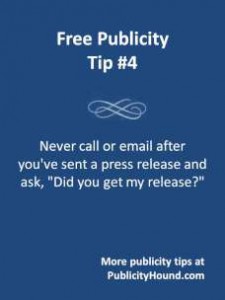You’re a journalist working in a newsroom. Ten times a day, people call and ask, “I sent a press release last week but it hasn’t shown up in the paper yet. Can you confirm you received it?”
You drop what you’re doing, call up your email from the last seven days and meticulously scroll through it, looking for the press release in question. You return the phone call and explain that yes, you received it, or no, you didn’t. How much time do you think you’d waste if you did that 10 times?
Yet people keep making annoying follow-up calls after they send press releases. Some of them also ask, “Do you know when it will be printed?”
No, most times, journalists don’t know. If they rewrite your press release, it goes to the editor in charge of the section where the release will appear. And the editor schedules it. A variety of factors can bump that press releases from the the section. And the last thing a busy reporter wants to do is chase after your release and find out when it’s scheduled to appear.
If you’ve emailed or snail-mailed a release, assume it reached its destination. Don’t make an annoying follow-up call.
Twenty years ago, we wrote releases only for the media. Today, we write them primarily to post online so they pull traffic to our websites.
Besides, if you want major coverage of a story, sending a press release is the lazy way to get the media’s attention. You need to deliver a customized pitch.


[…] Why press release follow-up calls irk journalists from The Publicity Hound’s Blog by Joan If you’ve emailed or snail-mailed a release, assume it reached its destination. Don’t make an annoying follow-up call. Twenty years ago, we wrote releases only for the media. Today, we write them primarily to post online so they pull traffic to our websites. Besides, if you want major coverage of a story, sending a press release is the lazy way to get the media’s attention. You need to deliver a customized pitch. […]
Insightful article Joan
According to the above mentioned example/assumption you are right people make lot of follow-up calls but I think their aim is not to disturb you but to make themselves clear whether their submission is going to be printed or not… but in other ways you are right
that if someone want about his/her story to be covered on a large scale there are other ways to be utilized.
A lot of people think that they aren’t bothering journalists by asking if or when an item will be printed. Point is, journalists almost never know for sure. Thanks for joining the conversation, Jessica.
Great article! Totally agree not to ask ‘did you receive my press release’, but with the number of emails journalists receive, I don’t like to assume it’s reached its destination either. I usually send the release, then call round and pitch the story in a nutshell. Journalists will usually say ‘oh yes, i’ve had a press release on that – it’s running soon’ or ‘I had a press release on that but it wasn’t for us’ or they’ll ask me to send it through to their own email if they’re interested in visiting the story and haven’t seen a release. It’s been a pretty successful method so far, and has been a great way to build relationships.
Following up a press release with a related pitch is fine. I’m glad this works for you. Thanks for adding to the conversation, Ellie.